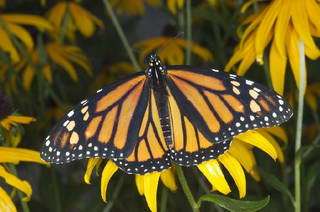How Butterflies Fly Thousands Of Miles Without Getting Lost Revealed By Researchers

While "navigation" systems in automobiles are a fairly new (and still costly) innovation, monarch butterflies have managed for millennia to navigate their way for a distance of some 3000 miles (4800 kilometers) each fall from Canada to Mexico (and vice-versa in the spring) without losing their way.
The phenomenon of long-range bird migration is a well-known one, but not in the insect world. Also, among birds their migration route is a round-trip one, which they make more than once in their lifetimes, while for the monarch it is strictly a one-way trip for each butterfly. How do these creatures do it?
The mystery of the mechanisms involved in this remarkable phenomenon has been resolved by a team of scientists who did this by exploring the infinitesimal butterfly brain and eye tissues to uncover new insights into the biological machinery that directs this delicate creature on its lengthy flight path.
The research team, led by Prof. Steven Reppert of the University of Massachusetts Medical School, included Dr. Oren Froy, now of the Faculty of Agricultural, Food and Environmental Quality Sciences of the Hebrew University of Jerusalem. Others involved were from the Czech Academy of Sciences and the University of California, Irvine. Their latest findings were published in a recent issue of Neuron magazine, constituting a continuation of their earlier work, published in the journal Science.
While light in general is essential to the functioning of the “biological clock” in the butterfly brain – governing its metabolic cycles, including its “signal” to migrate -- the researchers discovered that it is specifically the ultraviolet band of light that is crucial to the creature’s orientation. The butterflies have special photoreceptors for ultraviolet (UV) light in their eyes which provide them with their sense of direction.
They proved that this ultraviolet “navigation” is crucial by placing butterflies in a “flight” simulator. When a UV light filter was used in the simulator, the butterflies lost their orientation
Further probing revealed a key wiring connection between the light-detecting navigation sensors in the butterfly’s eye and its brain clock Thus, it was shown that input from two interconnected systems – UV light detection in the eye and the biological clock in the brain -- together guide the butterflies “straight and true” to their destination at the appointed times in their two-month migration over thousands of miles/kilometers.
Source: Hebrew University of Jerusalem















